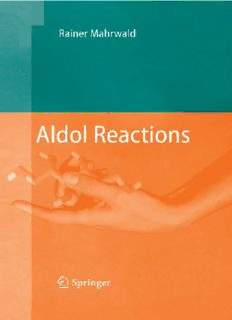
Aldol Reactions PDF
Preview Aldol Reactions
Aldol Reactions Rainer Mahrwald Aldol Reactions Rainer Mahrwald Institute of Chemistry Humboldt University Brook Taylor Str. 2 12 489 Berlin Germany [email protected] ISBN:978-1-4020-8700-4 e-ISBN: 978-1-4020-8701-1 DOI: 10.1007/978-1-4020-8701-1 Springer Dordrecht Heidelberg London New York Library of Congress Control Number: 2009922617 © Springer Science+Business Media B.V. 2009 No part of this work may be reproduced, stored in a retrieval system, or transmitted in any form or by any means, electronic, mechanical, photocopying, microfilming, recording or otherwise, without written permission from the Publisher, with the exception of any material supplied specifically for the purpose of being entered and executed on a computer system, for exclusive use by the purchaser of the work. Cover illustration: Photographs by the author Cover design: WMXDesign GmbH Heidelberg Printed on acid-free paper Springer is part of Springer Science+Business Media (www.springer.com) Preface Without doubt, the aldol reaction belongs to the most important methods of stereoselective C-C bond formation processes. One of the requirements of modern synthetic methods is receiving chiral products in their enantiomerically pure form or pure diastereoisomers. This requirement is not only important for synthetic chemistry but also an imperative for nature. The aldol reaction fits in easily with nature's chemistry. A great number of enzymatic transformations are based on the aldol addition. This fact has been known for a long time and was best expressed with the following statement: Nature, it seems, is an organic chemist having some predilection for aldol condensation. J. W. Cornforth in Perspectives in Organic Chemistry, Todd, A. Ed.; Wiley-Interscience, New York, 1956, page 371. The stormy and meteoric development in the field of aldol additions over the last 20 years has led to a plethora of options in the total syntheses of complicated natural products. This book illustrates the basic principals and the new variants of the classical aldol addition. This includes aldol additions with various metal enolates as well as metal complex-catalyzed, organocatalytic methods and bio- catalytic transformations. Moreover, advances made in the development of new aldol methodologies to provide pure stereoisomers are preferentially discussed in this work. The exciting progress being made in organocatalytic aldol additions is of par- ticular interest. This highly active topic of research will continue to develop an increasing number of new concepts of configuration-control. This idea is perfectly illustrated by the following scheme – something unimaginable 10 years ago. This scheme brings together organocatalyzed aldol additions and enzymatic transforma- tions, which flow perfectly into the idea of Cornforth mentioned above. v vi Preface OH OH OH OH O O OH OH OH OH OH OH fructose psicose O OHC + O O OH OH sorbose tagatose OH OH OH OH OH OH O O OH OH OH OH Using four different organocatalysts, an approach to four differently configured ketohexoses is possible today. In nature, on the other hand, a selective and asym- metric access to the described ketohexoses is accomplished by a family of four aldolases. These enzymes selectively target one of the four isomers of the 1,2-diol junction that link dihydroxyacetone with (R)-glyceraldehyde. Thus, an approach is given selectively to one of the four enantiomers by biochemical as well as organo- catalytic methods. It is now my pleasure to express my gratitude to my co-workers and my son for countless hours of assistance. Special thanks are also due to Springer UK, espe- cially to Miss Claudia Thieroff and Dr. Sonia Ojo. Humboldt-University, Berlin Rainer Mahrwald March 2009 Contents 1 Introduction ............................................................................................... 1 2 Aldol Reactions with Preformed Enolates ............................................. 7 2.1 Lithium Enolates ................................................................................ 7 2.2 Magnesium Enolates .......................................................................... 17 2.3 Boron Enolates ................................................................................... 23 2.4 Titanium Enolates ............................................................................... 39 2.5 Tin Enolates ........................................................................................ 59 3 Catalytic Aldol Additions ......................................................................... 69 3.1 Lewis Acid-Catalysed Aldol Reactions ............................................. 73 3.1.1 Titanium Lewis Acids ............................................................. 73 3.1.2 Tin Lewis Acids ...................................................................... 83 3.1.3 Boron Lewis Acids ................................................................. 97 3.1.4 Copper Lewis Acids ............................................................... 107 3.1.5 Silver, Palladium and Platinum Lewis Acids ......................... 117 3.1.6 Zirconium Lewis Acids .......................................................... 121 3.1.7 Miscellaneous Lewis Acids .................................................... 127 3.2 Lewis Base-Catalysed Aldol Additions ............................................. 131 3.3 Direct Aldol Addition ......................................................................... 141 3.4 Gold- and Rhodium-Catalysed Aldol Additions ................................ 155 3.5 Antibody-Catalysed Aldol Addition .................................................. 161 3.6 Enzyme-Catalysed Aldol Addition .................................................... 165 3.7 Organocatalysed Aldol Addition ........................................................ 177 Index ................................................................................................................. 205 vii List of Abbreviations 9-BBN 9-Borabicyclo[3.3.1]nonane ab Antibody Ac Acetyl AcOH Acetic acid ALB Aluminium–lithium–bis[(S)-binaphthoxide] complex Ar Aryl BDMS Benzyldimethylsilyl BINAP 2,2′–bis(diphenylphosphino)–1,1′–binaphthyl BINAPO 2,2′–bis(diphenylphosphinoxide)–1,1′–binaphthyl BINOL 1,1′-bi-2-naphthol Bn Benzyl Boc tert-butoxycarbonyl BOM Benzyloxymethyl box Oxazoline BPS tert-butyldiphylsilyl Bu Butyl Bz Benzoyl c Cyclo CAB Chiral acyloxyboranes Cbz Benzyloxycarbonyl COD Cyclooctadien Cp Cyclopentadienyl CSA Camphorsulfonic acid Cy Cyclohexyl DBU 1,8-Diazabicyclo[5.4.0]undec-7-ene DHA Dihydroxyacetone DHAP Dihydroxyacetone phosphate DIPEA Diisopropylethylamine DMSO Dimethyl sulfoxide Dppe 2-(Diphenylphosphino)ethyl Et Ethyl ix x List of Abbreviations FBP Fructose-l,6-bisphosphate FruA Fructose-l,6-bisphosphate-aldolase FucA L-Fuculose-1-phosphate-aldolase GABOB α-Amino-β-hydroxybutanoic acid HMDS 1,1,1,3,3,3-Hexamethyldisilazane HMG-CoA 3-Hydroxy-3-methylglutaryl-coenzyme A HMPA Hexamethylphosphoramide HYTRA Hydroxy-1,1,2-triphenyl ethyl acetate Ipc Isopinocampheyl LDA Lithium-diisopropylamine LLB LLB Lanthanium–lithium–BINOL Me Methyl MEM 2-Methoxyethoxymethyl Mes Methanesulfonyl MOM Methoxymethyl MS Molsieve NAL N-Acetylneuraminic acid lyase NeuA N-Acetylneuraminic acid aldolase Ph Phenyl PMB p-Methoxybenzyl PMP p-Methoxyphenyl Pr Propyl p-TsOH p-Toluenesulfonic acid pybox Pyridyl bis(oxazoline) RhuA L-Rhamnulose-1-phosphate-aldolase RibA 2-Deoxy-D-ribose 5-phosphate aldolase TagA Tagatose-1,6-bisphosphate aldolase TBAF Tetrabutylammonium fluoride TBAI Tetrabutylammonium iodide TBDPS t-Butyldiphenylsilyl TBS t-Butyldimethylsilyl TCE 1,1,1-Trichloroethyl TES Triethylsilyl Tf Trifluoromethanesulfonate TFA Trifluoroacetic acid THF Tetrahydrofuran Thr Threonine TIPS Triisopropylsilyl TMEDA N,N,N′,N′-Tetramethylethylenediamine List of Abbreviations xi TMS Trimethylsilyl Tol-BINAP 2,2′–bis(di-p-toluylphosphino)–1,1′–binaphthyl TPS Triphenylsilyl Tr Triphenylmethyl (trityl) TRAP (R,R)-2,2′-bis[(S)-1-(dialkylphosphanyl)ethyl]1,1′-biferrocene Troc 2,2,2-Trichloroethoxycarbonyl Ts p-Toluenesulfonyl
Description: